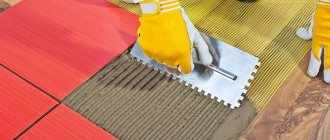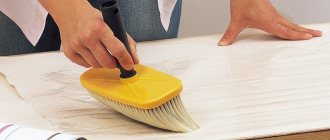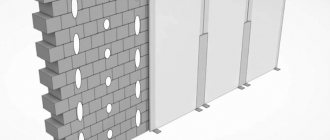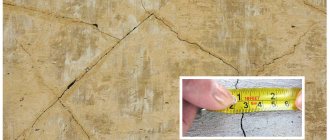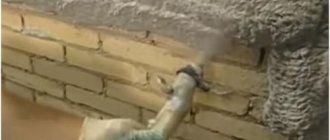Types of cracks
To know how to repair cracks in concrete, you must first determine what type it belongs to:
- Through cracks occur due to tensile forces;
- Surface cracks appear after the concrete has dried due to a violation of the mortar formulation;
- Cracks in the tension zone appear during bending and are directed transversely to the reinforcing bars;
- Cracks located at an angle to the reinforcement, which occur under the influence of shear force;
- Shrinkage cracks parallel to the reinforcement, which arise due to soil heaving, uneven shrinkage or improper anchoring. Due to such cracks, shrinkage and deformation of the foundation and the entire building occurs. Shrinkage cracks can also appear if the load calculation was not made according to the rules of SNiP;
- Small cracks that appear due to temperature changes;
- Hairline cracks occur for the same reason as the previous ones, but usually their depth does not exceed a few millimeters.
Having determined the causes and types of cracks, the type of repair work is determined.
Sealing cracks in concrete on horizontal and vertical surfaces, concrete repair mixture
Cracks on walls can have different directions, but most often they are vertical.
We suggest you familiarize yourself with Fill the floor with concrete along the beacons
The appearance of thin cracks less than 1 mm wide indicates that during construction in the structure or at the base of the foundation there are defects in work, errors in technology, or incorrectly selected materials.
It is necessary to conduct an analysis and carry out corrective actions on bedding, waterproofing, and additional strengthening of stone structures.
Fine cracks in concrete can be repaired with epoxy resin or liquid cement mixture. The ratio of cement and the finest sand is 1:1. Sand can be replaced with stone flour, for example, dolomite.
If you use epoxy resin, the crack must be thoroughly blown out and dried before sealing. If you use cement mortar, then first the crack must be treated with a deep penetration primer or at least moistened with water, removing dust and crumbs.
Usually thin cracks are puttied. Using the end of the tool or another thin metal plate, you need to try to “push” the solution into the depths of the crack as deeply as possible. After this, the surface is leveled with a spatula.
If the gap is large (several mm or more), in order to save money, you can add the same amount of quartz sand, fraction up to 1 mm, to the epoxy resin.
If you use a cement mixture, you can purchase ready-made cement adhesive for gluing heavy slabs or prepare the composition yourself, as was done during the construction of artificial rock and in the article about concrete tiles (how to glue concrete tiles).
This type of repair can be considered the simplest and at the same time the weakest. This is a temporary partial filling of floor, wall and foundation cracks in both dry and wet areas.
This filling of cracks does not seal them, but protects them from contamination for a while and prevents their further opening for a short time.
Repairs begin according to SNiP rules with the preparation of the opening itself.
It should be checked for chips, as other cracks and openings may form in them in the future. Use a chisel to run along the entire length of the crack to make it wider.
Next, clean the crack with water and a brush to remove various contaminants; you can also use a vacuum cleaner. Remaining water should be collected with a sponge.
Using a spatula, you should also deepen the crack to 5 mm so that the solution holds more firmly.
For repairs, make a solution of 3 parts sand and 1 part cement, to which you also need to add PVA glue. The solution should be thick enough.
Pour it into the crack with a trowel and moisten it on top. If you carry out repairs using a polymer mixture rather than using a concrete solution, you do not need to wet the composition.
In medium cracks, reinforcement is usually visible; it must be cleaned and coated with a special product that will prevent corrosion. Next, you need to make grooves and place 4 mm pieces of reinforcement in them.
Now we apply the adhesive composition evenly over the entire surface so that the layer thickness is about 3 mm, and without waiting for it to dry, you need to fill it all with the solution.
The solution must be compacted so that it gets into all the recesses and irregularities, and the surface must be leveled with a wooden strip, which must be moved along the surface of the solution to the right and left and towards you.
If the gap is very deep, it is advisable to lay the solution in several passes. At each stage, the surface should be sprayed with a little water.
A special metal trowel will help make the concrete surface perfectly smooth. When the solution has hardened, the excess must be removed with a spatula.
If you paint or cover the concrete surface with a laminate, then such work can be done within a day after the repair is made, but you should wait longer to lay the tiles.
If this does not happen, use a grinding machine to level the surface of the former crack to the desired level.
If you are dealing with a crack whose width and length are large enough, you can process it before repairing it with a circular saw with a diamond disk, after which the repair is carried out according to the scheme described above.
This method of sealing is most often used as a temporary solution, since sealing does not occur during such repairs.
The method is relevant for both dry and high-humidity rooms where good waterproofing is required.
An elastic sealant can also help seal cracks.
The most popular in this case is silicone glue - sealant. This sealant is used both for small cracks and for those whose width is quite large.
The repair process that requires the use of a sealant is no different from a repair that uses a concrete compound.
First you need to clean the crack from dirt, make grooves for better bonding of the material to the surface. When applying glue/sealant to the surface, it must also be moistened.
The sealant, unlike the cement mixture, dries in a short time, which makes this material much more convenient.
However, the sealant is noticeably more expensive, so not everyone can afford such repairs.
Epoxy resin and epoxy repair compound are also used to seal cracks in concrete.
First you need to open up the opening and remove loose concrete and chips. The width of the groove should be no more than 25 mm and no less than 4 mm.
Every 400 mm along the crack you need to make transverse grooves 150 mm long. Using a vacuum cleaner, collect all debris and dust and treat the seams with a primer.
Metal brackets for reinforcement are placed in the transverse grooves that were made earlier. Next, according to the instructions, dilute the epoxy solution and add a hardener to it.
The epoxy solution is sprinkled with sand on top, and after an hour the sand is removed with a vacuum cleaner.
Repairing a crack in concrete with epoxy resin is quite economical and takes very little time to dry. In addition, this treatment of cracks prevents their further movement.
It can be used for dry screed.
If you need to apply an epoxy resin coating to a liquid environment, you do not need to add sand to the mixture. You should also not sprinkle sand on top.
If you need to cover up cracks in a swimming pool or water tank, in an underground section of the foundation or on the external walls of a building where high-quality waterproofing is required, then the methods described above will not be enough to ensure the strength of the structure.
To treat the opening in such places, a special composition is usually used. The cost of such repairs is an order of magnitude higher than conventional methods, but in a humid environment it is completely worth it.
These materials ensure complete sealing of the crack, so the coating will last for many years.
Repairs are possible both indoors and outdoors, at any time of the year.
Repairs must begin, as in previous cases, by processing the opening. After all excess has been removed and the surface of the furrow has been cleaned with a vacuum cleaner, the width and depth are measured.
This is done in order to choose the right self-expanding cord for repair.
A cord is placed in the cut, which should lie without coercion, freely.
There should be 20-30 mm left to the bottom and top of the furrow so that the cord will expand further. Whatever type of cord you choose, you cannot force it.
Now polyurethane sealant is applied on top of the cord, the surface of which is smoothed with a spatula. The glue that has come out of the seam is removed with a sponge.
Usually it is written on the packaging which material is preferable for a given type of cord or tape; strictly follow the recommendations.
If you will use this material in relatively dry rooms, where waterproofing serves only for insurance, the finishing can be done using cement mortar.
We suggest you familiarize yourself with Pouring concrete in winter - how to prevent the material from freezing
Today the range of such products is quite wide.
This material consists of polymer resins and modified clay, and also contains bentonite material or its analogue, which binds the surfaces together and seals them.
As for the release form, they are as follows:
- Cord - the material is used for repairing shallow cracks of 30 - 50 mm;
- Tape - the material is placed in cracks 20 - 50 mm wide and up to 150 mm wide;
- Paste - sealant is used to treat small furrows;
- Mats hold together layers of concrete screed, and when the old coating is old, a new layer is laid.
The name of this method speaks for itself - injection involves introducing special materials into the voids formed in concrete by “injection”.
Injection allows you to repair concrete pavement without replacing the entire concrete pavement.
This is one of the most effective ways to repair these defects, which is also quite economical.
Injection involves introducing a cement, epoxy or polymer mixture into a crack under pressure, so that the mixture fills any small voids or cracks.
This makes the structure very strong and reliable.
This method is also used to waterproof concrete, for which different compositions are used.
Technologies for sealing cracks and potholes
If a crack or chip is found in a concrete structure, it must be repaired as soon as possible. This will prevent water from getting into it and protect it from external destructive factors. Repairing cracks in concrete can be done in several ways. Injection is the most effective method for deep cracks. With this method, the filling composition penetrates into voids under pressure, filling all internal pores and cavities, hardens and seals cracks.
As a filler, you can use sand-cement mortar with polymer additives. They give the solution elasticity and contribute to the waterproofing of the structure. Inclined diagonal holes are drilled along the crack, special bushings are inserted into them, through which filler is injected into the crack.
Cement mortar is used to repair small cracks and chips. First, check the crack; if there are chips around it, it is necessary to remove all pieces of concrete that have peeled off from the surface. Using a hammer and chisel, the crack is opened along its entire length. The depth of the embroidered crack must be at least 5 mm. Remove dust and concrete residues with an air stream from a vacuum cleaner, and wash the crack with water. Excess water is removed and the crack is filled with a solution consisting of cement, sand and PVA glue. The solution should fill the entire recess.
The use of epoxy resin to repair holes and cracks allows you to securely fix the seams, preventing their further increase, the work is performed in the following order:
- widen the crack to a depth of five millimeters;
- transverse grooves are made using a grinding machine with a diamond disk and secured with repair brackets;
- the recess is cleaned of dust and dirt and primed;
- prepare a solution from the resin base, hardener and sand in accordance with the instructions;
- Fill the prepared recess with the resulting composition and immediately level the surface with a spatula, since the epoxy hardens very quickly.
Sealing cracks and chips using sealants and self-expanding tapes is an expensive method, although it has a number of advantages: it ensures complete tightness, copes with various types of defects, and work can be carried out in any weather.
What are the types of cracks in concrete?
Cracks that appeared from water, or rather from its constant exposure.
Methods for eliminating damage vary depending on their type. There are different types of cracks in concrete:
- Through. Appear due to excessive axial tensile forces.
- Cracks in the tension zone. They arise when bending and are directed at an angle of 90 degrees to the reinforcement bars.
- A power crack in concrete appears due to the action of a transverse force (shear crack) - directed at an angle to the reinforcing bars.
- Hairline cracks in concrete are caused by temperature differences, but they are very shallow.
Hairline cracks
- In the vicinity of the reinforcement anchorage, cracks may appear running parallel to the reinforcing bars. The reason may be incorrect anchoring, swelling of the ground, or improper settlement of the building.
- Technological cracks in concrete are caused by sharp changes in the temperature of the concrete surface and deeper layers. Also, such defects can occur if the manufacturing technology of the product is violated.
What are the types of concrete damage and its causes?
To understand the causes of damage, you need to know the properties and composition of concrete. It is prepared from cement, sand and water. I use crushed stone as a filler, and to improve performance characteristics I use special additives, for example, plasticizer, fiberglass. For strength, the concrete structure is reinforced with reinforcement.
When the solution hardens, it shrinks, in other words, it contracts. The resulting artificial stone is strong in compression, but not resistant to tension. When such forces act on it during operation, defects are formed.
Damage can be of the following types:
- Loosening the overall structure. Defects may not be visible visually, but minor damage reduces the strength of a concrete structure.
- Surface destruction. The defect appears on the upper layers of concrete in the form of chips and potholes.
- Destruction of deep layers. The defect is manifested by cracks that form in loose areas of the concrete structure.
In general terms, there are two reasons for the occurrence of the destructive process of concrete: violation of the technology of its production and from old age. There are no questions with the first factor. If the solution is made incorrectly, then the concrete structure will be of similar quality.
As for old age, the following factors influence the acceleration of the process:
- excessive mechanical loads;
- exposure to chemicals;
- increase in physical processes caused by thermal expansion;
- corrosion of the reinforcing frame.
If the initial stage of damage is detected, it is urgent to repair the old concrete to prevent it from further destruction.
Sealing cracks in concrete on horizontal and vertical surfaces, concrete repair mixture
The photo shows a repaired crack in concrete.
In newly laid concrete (two hours old), cracks can be eliminated by compacting the compound a second time.
Other methods are used to eliminate cracks in hardened concrete:
- Injection – repair mixture is injected into the opening under pressure. There are mixtures for sealing cracks in concrete, which make it possible to remove moisture from the cracks. Suitable for use in water.
Injection method
- Sealing. For the walls, materials are used to seal cracks in concrete with the addition of a polymer, which increases the adhesion of the base and repair composition.
Sealing method
- Torquetting or spraying concrete mortar onto the surface. This is an effective and global repair process. It is produced using specialized equipment. As a result, you will get a new layer of concrete that protects the structure from corrosion and further destruction.
Restoring the pier using torquetting
To repair cracks, a concrete mixture is used to seal cracks in concrete; after jointing and cleaning the cracks, it is filled with a new composition.
How to repair a crack in a concrete wall using this method? A concrete mixture is used. It consists of fractional sand, water, cement and an organic additive, which can be resin, bitumen, latex. This method is not always convenient to use, since it causes an increase in the weight of the structure, and, consequently, an increase in the load.
Repaired cracks in concrete - grouting with ordinary cement-sand mortar
Let's take a closer look at what it means to seal cracks in a concrete wall using various technologies.
Injection
Schematic illustration of the concrete wall injection process
A common method is injection. In order to inject cracks in concrete and repair cracks in concrete walls, polymer materials are added to them using “injections.” This type of repair makes it possible to do without fragmentary replacement of the concrete structure.
To carry out such an operation you will need specialized equipment and materials. Therefore, you can’t hope to independently reproduce the work. If you are interested in how injections are carried out by specialists, watch the video below.
Sealing
Sealing grout for cracks in concrete
Sealing is the application of a solution to a deformed surface to seal cracks in concrete, consisting of a polymer component and a cement-sand mortar. After the mixture dries and hardens, an additional thin layer of polyurethane sealant is applied to it.
This method is indispensable for reinforced concrete structures, which are often exposed to moisture and atmospheric influences. If you have experience in carrying out such work and the necessary material, then you can carry out the sealing yourself. The video in this article below will tell you how to seal cracks in concrete using the sealing method.
The best method of dealing with damage in concrete is to prevent it from occurring.
Therefore, it is worth taking care of the quality of the concrete structure in advance:
- Violation of the ratio of water and cement is a very common reason for a decrease in quality and further active cracking. So special attention should be paid to maintaining proportions when preparing the cement mixture.
- When laying the mortar, it must be seriously compacted using vibrators. It is also necessary to carry out proper maintenance of fresh concrete. To prevent too much moisture evaporation, new concrete can be covered with fabric.
Vibration on the site
- The most dangerous damage occurs in concrete located in conditions where frequent temperature changes occur beyond 0 degrees. When it’s cold, the moisture that has flowed into the opening expands, aggravating the problem. The reinforcement becomes visible, it corrodes and the durability of the structure decreases.
- To promptly detect cracks and eliminate them, it is necessary to systematically inspect the concrete surface and notice obvious defects. This will allow cracks to be localized at the initial stage of their appearance and thereby reduce the number of repairs. Experts do not recommend delaying the repair of even small concrete defects.
As you can see, there is nothing impossible or inaccessible to repair a concrete surface with your own hands. Of course, it’s better to avoid such troubles, and then you won’t have to rack your brains over how to repair a crack in concrete.
In any case, high-quality artificial stone is not only durable, but also susceptible to repair work, which will extend its service life for many years. The main thing is to do everything correctly and carefully.
Filling potholes in concrete floors, and even small cracks, requires additional labor and financial costs. It’s especially unfortunate to waste time on such work when deadlines are tight. And such a period in construction, even if it is done on its own, rarely passes.
Therefore, a reasonable question arises: is it generally necessary to seal holes in a concrete floor? This is not a finishing layer, but just a rough one, which will still be covered with several layers of coating.
An unacceptable defect that appeared as a result of mechanical action.
Therefore, any normal craftsman will not only advise you to get rid of any defects on the base, but will also tell you how to repair a crack in a concrete floor of any complexity with your own hands.
To correct uneven floors, there are methods that are used most often in the household and separately in industrial use. These methods differ from each other in the surface area on which a certain mixture is applied, the composition of this mixture and other characteristics.
Ideal concrete surface
Despite this, sealing cracks in concrete floors with different compositions follows the same technology, and the differences are insignificant. Let us list the main characteristics of methods for correcting floor damage.
We suggest you familiarize yourself with How to make a roof on a bathhouse from foam blocks
Industrial method
You can not only repair defects in the foundation yourself, but also hire specialists who will competently carry out all the work. Of course, the price for their services will be considerable. They are usually used for large damages in significant areas - shopping centers, industrial facilities.
It can be produced in several ways:
- Injection. This method in its structure resembles the mechanism of injection. So, polymer compounds are added to existing cracks, thereby sealing them. This allows you to not carry out a more serious replacement of floor or wall coverings for some time, but to limit yourself to the local effect.
The repair composition involves treating the defective surface with a mixture that includes cement, sand and polymer additions. After the applied layer has dried, an additional polyurethane sealant is applied on top.
- Shotcrete involves applying special solutions to areas prone to drying out and the formation of depressions. The ingredients of this solution are substances such as water, cement, fractionated sand and special organic additives. However, when applying the final layer of mortar, you need to take into account that it will begin to put more pressure on the foundation.
Shotcrete is not only a global repair of surfaces, but also a method for their manufacture.
Of course, thinking about how to repair potholes in a concrete floor using the gunite method yourself is not a fruitful pastime. Such work is carried out with special expensive equipment, and the process itself requires the knowledge of a specialist in this field.
If the foundation is damaged on a small scale, it is not necessary to call a team of concrete workers; you can deal with this problem yourself using different compounds:
- Special repair mixtures are actively used as a material for sealing large and small depressions.
- The cement-sand composition, or as they say otherwise, “dough” is suitable for miniature recesses, with a diameter and depth not exceeding three millimeters. In cases where cracks are larger than the designated diameter, a special mixture of Portland cement, water and sand 1:3 is used. PVA glue is also added to this solution.
How to fill holes in a concrete floor? It is best to use pieces of reinforcement for filling, or to make real concrete by adding crushed stone to the cement-sand composition. This will only strengthen the “patch”, preventing it from cracking.
How to seal cracks in a concrete floor yourself: a cement-sand repair composition is cheap, effective and easy to use
When preparing one of the above compositions, the main thing is not to overdo it with the addition of water, which, as already mentioned, causes additional cracking.
In order to bridge cracks in concrete surfaces, prepare the following necessary tools:
- grinding machine;
- metal iron;
- wire;
- wooden slats;
- trowel;
- paint brush;
- putty knife;
- special gloves;
- brush;
- chisel;
- hammer.
A few instructions to help you deal with sealing cracks:
- Prepare your workspace. Inspect not only the crack itself, but also the areas adjacent to it. Otherwise, the places near the crack may eventually turn into depressions that will disrupt the integrity and symmetry of the floor.
- Using a hammer and chisel, work into the defective space and widen the cracks. If, when inspecting the floor, you find a hidden chipped part, remove the damaged surface completely. Cracks can be deepened using diamond wheels for cutting reinforced concrete.
- Treat the floor near the defect. A vacuum cleaner will help clean the surface from dust, also clean it with a brush and soapy water. Next, rinse the floor with water and proceed to the next step.
- Make a deepening in the crack so that the new solution can penetrate firmly and deeply into all fragile places. In this case, the restored part will last a long time and without problems.
- Now start preparing the solution. Its components should be as follows: sand and water (3:1) with the addition of PVA glue. The resulting mixture should not be too thick, or, on the contrary, too runny.
- Using a trowel, place the prepared mixture into the recess and fill the resulting mass with water. If you purchased a mixture of polymer compounds, wetting with water is not required.
- If the cracks are large, the components of the reinforcement can be visible through them. In this case, you need to clean the surface with a vacuum cleaner and soapy water, and then pour a specialized liquid into the damaged elements to prevent corrosion. In addition, small pieces of wire can be placed in the recesses.
- Prepare the adhesive compound and distribute it evenly over the damaged floor surface. The layer of adhesive solution should not be too thick (about 3 millimeters).
- Continue filling the cracks until the liquid begins to dry. Fill the surface gradually, without rushing: in this case, the liquid will fall more evenly on the surface.
- Level off the top of the applied compound. Use a rack to skim off excess mixture.
To properly seal cracks in a concrete base, it is better to make them wider
Industrial method
- grinding machine,
- metal ironing board,
- wire,
- wooden slats,
- trowel,
- paint brush,
- putty knife,
- special gloves,
- brush,
- chisel,
- hammer.
Elimination of defects
Oddly enough, before repairing a crack in a concrete wall, it must first be widened. That is, to increase the size of the damage. This will get rid of weak edges and add area to that part of the defect that will be in contact with the solution and improve its adhesion. You can increase the size of the cracks with a chisel or cut the recesses nearby with a grinder so that after this a larger recess is formed.
Next, you need to clean everything from dust with a brush or vacuum cleaner and thoroughly wash the repaired area with soap and water. The next step is to apply the primer. Afterwards, the recess or channel is filled with the solution that you bought or prepared. Everything needs to be filled tightly and so that the repaired area protrudes slightly above the rest of the plane. After the patch has dried, sand down any uneven areas.
There is another option, how to seal a gap in a concrete wall without dirty work. When a sealant or resin is used, the job will be a little different. It may also be necessary to perform preliminary jointing of the defect, although in some cases this is not necessary - with very small crack sizes. They simply fill the defect with epoxy or sealant and wait until it completely polymerizes.
Sealing cracks in concrete on horizontal and vertical surfaces, concrete repair mixture
The above methods apply to production repairs. If you need to repair small cracks at home, then watery cement “dough” and proprietary repair mixtures are used for this.
Epoxy resin is also effective for cracks in concrete. Liquid “dough” is used for defects no more than 3 mm, and for larger ones a proprietary solution or a special mixture is used, which consists of 1 part Portland cement, 3 parts each of water and sand, as well as PVA.
Instructions for reproducing independent restoration work:
- Before starting work on sealing with cement-lime mortar, preliminary preparation is necessary. First you need to check the crack itself to see if there are any chips nearby, since in the future they can become shallow pits.
- Next, using a chisel and hammer, we go over the entire surface to make it wider. You can also use a grinder. If during this work a hidden chip appears, then this piece of concrete must be removed immediately.
- Then you need to clean the surface using water, a brush and a special product. In order to remove dust and dirt, you can also take a vacuum cleaner. Using a sponge, remove the remaining water.
Expanding cracks using an angle grinder
- To ensure that the solution for sealing cracks in concrete fills the entire area and holds strong and durable, we make the cracks deeper using a spatula up to 5 mm. The solution is diluted from 3 parts sand and 1 part cement. Be sure to add PVA glue. In this case, the solution is not liquid, but of normal thickness.
- You need to fill the cracks with the solution using a trowel, and then you need to wet the repair areas. Such actions with water are not necessary if you are using a polymer composition rather than a solution.
Freshly repaired crack in the floor
- If the opening width of cracks in concrete is larger and reinforcement is visible in it, it must be cleaned and treated with a solution that protects against corrosion. To secure it into the grooves, you need to lower pieces of wire of the same length, the diameter of which is approximately 4 mm. Then we apply the adhesive composition with a brush and spread it over the surface of our uneven surfaces. The layer thickness is about 3 mm. Then everything is filled with the solution; we don’t wait for the composition to dry. It is necessary to pour it in stages so that the solution fits tightly.
- Using a wooden lath, we level the surface, pushing it towards us and from side to side. When the hole is very deep and large, the solution must be poured in several layers, with the next layers softened with a little water. You can perfectly level the surface using a metal trowel or a regular trowel.
Repairing cracks in concrete - smoothing
- Afterwards, the excess solution is removed with a spatula.
- It should be noted that the layer of mortar should be approximately 0.5 mm higher than the floor surface, since the mortar will shrink after drying.
Elastic sealant
If you are wondering how to seal cracks in concrete more reliably and durablely, then know that it is better to use an elastic sealant. It is suitable for repairing both small and large splits. The repair process using this material is no different from that indicated above.
The advantage of elastic sealant is its tendency to dry quickly. However, when compared with mortar, this method of repair will be more expensive, since the price of the main material is high.
Repair of concrete floor screed
Screed repair depends on the type of defect. The most common screed defects are cracks and chips. In addition, hidden voids and detachments may form. They are detected by tapping with a metal rod.
A dull sound indicates the presence of voids. If the area of the damaged area occupies more than 30%, it is advisable to replace the old screed with a new one. A smaller area of damage can be restored.
Repair of small cracks
Before repairing, the area to be repaired must be cleaned. Expand the crack using a chisel and hammer to a depth of 1 cm. In cross section, the recess should look like a cone with a narrow part at the bottom. The area is then cleaned and dusted again.
To do this, use a vacuum cleaner or sandblaster. The surface of the recess is treated with epoxy primer diluted with solvent (1:10) and allowed to dry. This is necessary for a stronger bond between the base and the repair compound. Next, the gap is filled with solution. After the mixture has dried, the surface to be repaired is ground and cleaned.
Repair of deep cracks
After cleaning the area to be repaired, the crack is expanded using an angle grinder (grinder) to a depth of 5 cm. To do this, deep grooves are made on both sides of the crack. Then, using a chisel and hammer, all chipped concrete is removed, and the crack deepens. Next, the area to be repaired is dust-free and coated with an epoxy primer.
The solution is applied in two, and if necessary, in three stages. It depends on the size of the crack. If the crack is too wide, metal brackets must be installed. To do this, cuts 2 cm deep and 1.5 cm wide are made across the recess. After adding the repair mixture to these cuts, reinforcement is laid. Then the entire recess is sealed with mortar. The final stage is grinding the surface to be repaired.
Repairing Potholes
The peeled area is cleaned around the perimeter to a depth of 2 cm using an angle grinder. All concrete inside the cavity to a depth of 2 cm is removed using a hammer drill. The resulting depression is dusted with a sandblaster or vacuum cleaner and primed. Then the recess is filled with repair mortar and leveled. After the composition has hardened, the surface to be repaired is ground and cleaned flush with the floor.
Attention! Depressions larger than 5 cm are filled with solution in several stages.
Dust removal of screed
Over time, exposed to daily exposure, the screed begins to gather dust. This happens even if the floor covering is laid on the screed. To prevent excessive dusting, the surface must be dedusted.
Special mixtures such as Elakor or Ashfor will be a good assistant in eliminating this defect. You just need to choose the brand of the composition. The choice depends on the load to which the floor is subjected.
Before applying the composition, the concrete surface is thoroughly cleaned. For better adhesion, you can sand the floor. After removing the dust with a vacuum cleaner, apply impregnation using a roller. Modern compounds not only help remove dust from the screed, but also increase the wear resistance of the surface.
Repair of floor screed by injection
There are cases when the concrete floor screed peels off from the base. The voids formed in this case negatively affect the wear resistance of the screed. This problem can be solved without resorting to drastic measures. By tapping the entire surface with a hammer, the location of voids is determined. In these places the hammer will make a dull sound.
Having thus determined the contours of the delamination zones, holes with a diameter of about 16 mm are drilled in these places in increments of 240 mm. Having filled the construction syringe with a repair composition of low viscosity, pour it into the holes. This is done gradually so that the composition fills the entire cavity. The day after surgery, you can begin applying the protective coating.
Leveling the base
Quite often, before laying the laminate, unevenness of the base is discovered. Differences in height do not allow us to achieve what we want. Therefore, first of all, it is necessary to level the screed. The easiest way to correct the situation is to use a self-leveling mixture.
Before using the composition, the surface must be prepared. Remove dust and rinse twice with soda solution. The base is moistened. The mixture is prepared in small portions, applied to the floor and leveled. A needle roller removes air bubbles from the composition.
Replacing the old screed
The listed actions are good if the area of the damaged surface does not exceed 30%. Otherwise, it is advisable to replace the floor screed. Before replacement, the coating is sanded. Using special mixtures, heavily contaminated areas are cleaned. The prepared base is coated with a primer. If repairs are carried out in rooms with high humidity, it is necessary to use a water-repellent composition.
The self-leveling mixture is prepared and applied in small portions. After each application, roll the composition over the surface with a needle roller. This helps remove air bubbles that reduce the performance of the coating. The layer thickness can be from 5 to 10 cm.
Prevention of crack formation
Even at the stage of pouring concrete, it is very important to ensure that the concrete composition of the floor and foundation is of high quality, in compliance with all proportions.
When laying concrete, you need to carefully compact it not only manually, but also using a special tool.
In addition, today there are special preparations on sale that will protect the concrete coating from cracks and chips when in contact with water.
These means should not be neglected, since waterproofing is very important for the integrity of the concrete coating.
Waterproofing walls and foundations using such means will help prevent further cracks from opening.
